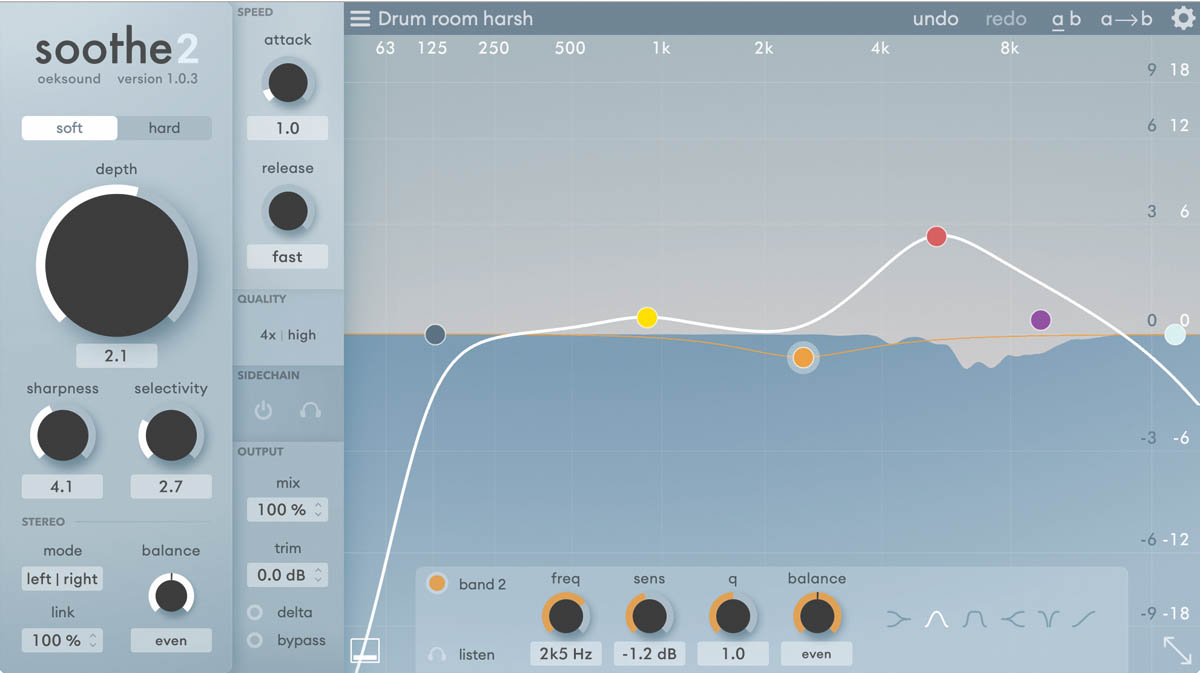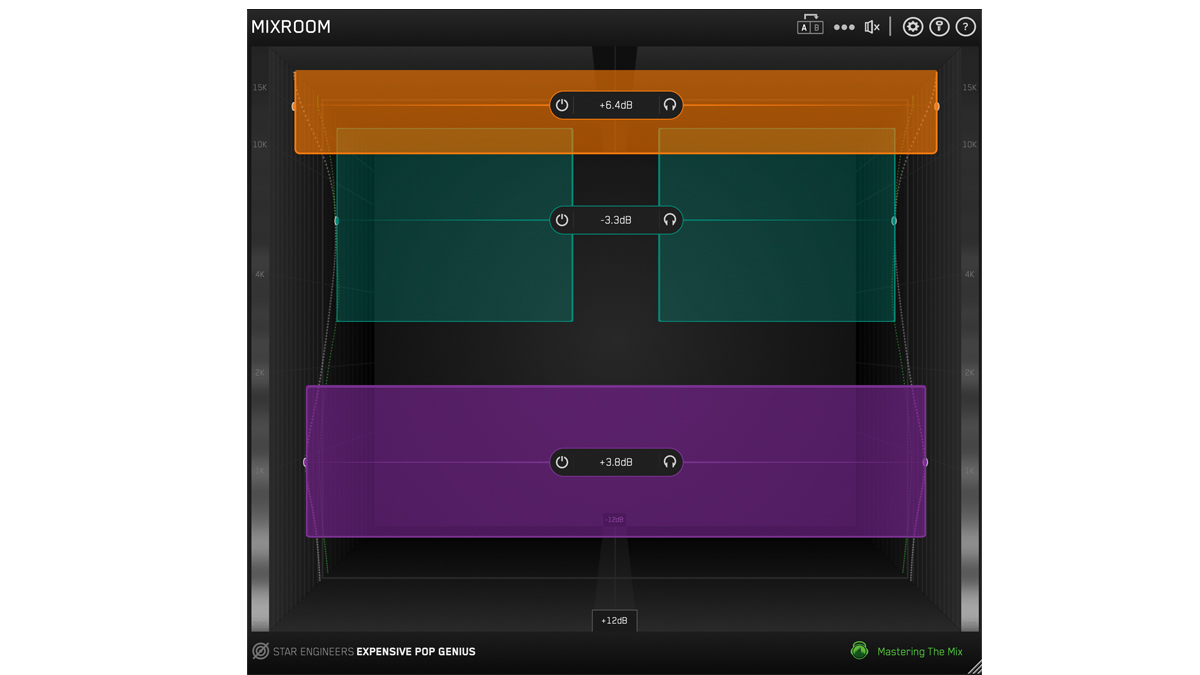MusicRadar Verdict
If you’re looking to streamline your mixing and mastering tasks, Mixroom combines a fresh interface with intelligent curve generation and analysis of user audio files.
Pros
- +
Both manual and intelligent EQ curves with a fresh interface.
- +
Excellent choice of mastering presets.
- +
Analyse your own audio files.
- +
Mid-side processing.
- +
Band specific solo.
Cons
- -
No frequencies below 320Hz.
- -
Needs more instrument presets.
MusicRadar's got your back
What is it?
Mastering The Mix first got our attention with their easy-to-use Levels metering plugin. Since then the team have delivered some excellent plugins aimed at making your mixing and mastering tasks quicker and the outcomes better.
Last year’s Bassroom EQ plugin is a perfect example, delivering bass-focused EQ via their innovative 3D style vertical layout.
Their latest plugin, Mixroom (VST, VST3, AU, AAX) employs the same layout, but this time the EQ handles frequencies from 320Hz to 20kHz. The plugin combines manual and intelligent operation, incorporating both presets and the option to analyse your own audio files. Let’s take a look at what’s on offer.
Layout
Mixroom is an 8-band configurable EQ that uses a vertical layout with high frequencies at the top of the window and low frequencies at the bottom. Each band is represented by a coloured box which you can move and adjust.
The height of the box is the bandwidth and the vertical position defines its frequency. The graphic sits in a 3D space and gain adjustments change the box size to give the impression it’s nearer for gain boost and further away for cut.
Mixroom’s true power lies in its intelligent EQing capability, done by target and analysis
Each band includes solo, bypass and the option to rebalance the mid and sides components. You can also process just the mid or just the sides component alone, though not both independently using the same band.
Bands can overlap completely, so you could use two bands to achieve this outcome or simply as a way to achieve more gain at a specific frequency. Bands up to 1.6kHz are peak shape and above this can be set to either peak or shelving. However, there’s no low shelf option or high and low pass filters.
The overall EQ mode can be set to either linear or minimum phase, and there’s an additional global option to set the EQ to either mixing or mastering mode. This influences the overall gain and Q bandwidth available, with the mastering setting offering a maximum of +/-4dB and mixing +/-12dB.
Note that neither setting offers massive cut and boost or super narrow bandwidths. Rounding things off is global bypass and output level, and this incorporates a suggested trim to help you match pre and post EQ levels.
Performance and verdict
Intelligent
If you’re confident enough at EQing then Mixroom makes for a pretty decent experience. The plugin opens as a blank canvas to which you can add bands individually or collectively.
That being said, the vertical layout makes more sense – although it does take a bit of getting used to, as does the fact that the EQ doesn’t handle the bass frequencies.
However, Mixroom’s true power lies in its intelligent EQing capability and this has two aspects. The first part is a target curve, sourced from more than 100 instrument and mastering presets or by loading up a reference audio file (see boxout).
The second part is the analysis of your audio, which takes a few seconds when you start playback. This generates a green target EQ curve visible down the sides. You can then try to match the EQ curve, which is grey, either manually or intelligently by selecting the Add Smart Bands option, which creates the required bands with suitable frequency, bandwidth and gain settings.
So, does it work? We tried Mixroom on a number of individual tracks, submixes and mixes and for the most part the results were very good.
Understandably, you need to select a representative section of audio to analyse, and this is particularly true if you’re processing a full mix, as the frequency content may change considerably from section to section.
In use the analysed target is easy to reset if you need to try a different section. So, as a mix tweaking processor it’s great, providing a quick way for a novice to get a handle on how their overall mix EQ stacks up.

• iZotope Neutron 3
Includes an excellent analysis and EQ curve generation feature.
• Soundtheory Gullfloss
Audio analysis and simple controls for wonderfully intelligent EQing.
Similarly, for the more experienced engineers out there, the presets provide insight into the overall tonality of different genres, and we particularly liked using the handful of Star Engineer presets.
On individual instruments the results were more varied and although we had great results with piano, strings and individual drums sounds, the overall drum kit settings were less successful.
Furthermore, on sounds that needed very heavy EQ, Mixroom didn’t always prove itself able to deliver enough boost to match the target curve. On balance we felt that having a bigger choice of instrument presets would certainly help.
Create a target
In addition to the included presets, Mixroom can create a target curve from an audio file, allowing you to match your current audio to an existing track or mix.
To access this feature you click on the target icon next to the preset browser. This opens an additional panel from which you can load and manage up to 20 source files.
By setting the respective DAW track to input monitor, source files can be auditioned within the plugin and this helps you choose which sections to use to create the target EQ curve.
Multiple sections of the source audio can be highlighted, and once you’ve done this you simply hit the Create Targets tab below. Closing out the panel gets you back into the main window and from here you proceed just as if you’d loaded a regular target preset.
Should you want to go back to the source audio or select a different source file simply reopen the window, and if you want to choose a different section from an existing source audio file, simply highlight that section and rerun the Create Targets option.
Value
Overall, Mixroom provides a fresh approach to EQing that is both informative and can save you time. The interface makes sense conceptually and after the initial learning curve it’s easy to use. What’s more, the analysis and accompanying presets can be very educational.
It’s important to note that the plugin isn’t really suitable for surgical EQing and by design doesn’t handle bass frequencies. That said, with such an attractive price you could justify buying Bassroom as well.
MusicRadar verdict: If you’re looking to streamline your mixing and mastering tasks, Mixroom combines a fresh interface with intelligent curve generation and analysis of user audio files.
Hands-on demos
Plugin Boutique
MachineCityAudio
Mastering the Mix
Specifications
- TYPE: Intelligent EQ (VST/AU/AAX plug-in)
- KEY FEATURES: More than 100 instrument and mastering presets, target EQ, gain display range, bypass/solo function for individual bands, vertical EQ display layout, level match, user-created target EQ values, load On Master or individual Channel
- SYSTEM REQUIREMENTS: macOS 10.8 and newer as 64-bit AU, VST 2/3 or AAX host; Windows 7-10 as 32-bit or 64-bit VST 2/3 or 64-bit AAX host.
- CONTACT: Mastering the Mix
Computer Music magazine is the world’s best selling publication dedicated solely to making great music with your Mac or PC computer. Each issue it brings its lucky readers the best in cutting-edge tutorials, need-to-know, expert software reviews and even all the tools you actually need to make great music today, courtesy of our legendary CM Plugin Suite.











